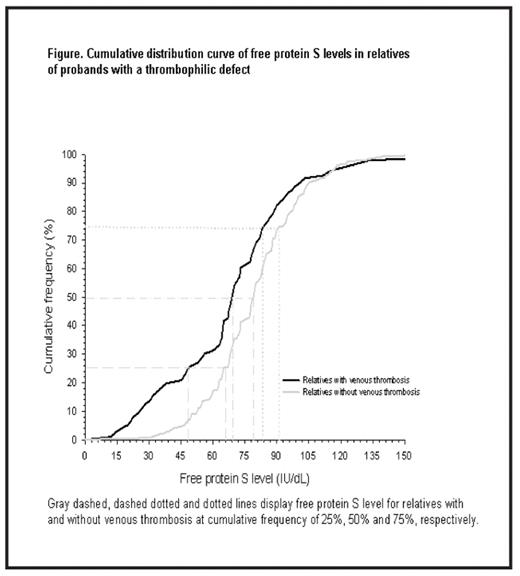Abstract
Conflicting data have been reported on the risk for venous thrombosis in subjects with protein S type III deficiency. As some studies included subjects with protein S type I deficiency, combined with an inadequate cut-off level for defining protein S type III deficiency (i.e. lower limit in healthy volunteers, generally < 65 IU/dL) might explain this discrepancy. We performed a single center retrospective study in a large cohort of families wherein probands had thrombosis and a thrombophilic defect, to define an optimal free protein S level that can identify subjects at risk for venous thrombosis. Probands were excluded as were relatives with protein S type I deficiency. Free protein S antigen levels were measured after precipitation of protein S complexed with C4b-binding protein with polyethylene glycol. 1143 relatives were analyzed. Mean age at onset of the first episode of venous thrombosis was 39 years. Relatives with venous thrombosis had lower free protein S levels than relatives without venous thrombosis (P< 0.001), which was most pronounced in the lowest quartile (Figure). Only relatives with free protein S levels below the 5th percentile (< 41 IU/dL) or below the 2.5th percentile (< 33 IU/dL) were at higher risk of first venous thrombosis compared to relatives with free protein S levels in the upper quartile (³ 91 IU/dL); annual incidence 1.20% (95% CI, 0.72–1.87), and 1.81% (95% CI, 1.01–2.99), respectively; hazard ratio, adjusted for age, sex and thrombophilic defects 6.7, (95% CI, 3.3–13.5) and 11.3 (95% CI, 5.2–22.1). Recurrence rates in these subgroups were 12.12% (95 CI, 5.23–23.88) and 12.73% (95% CI, 5.12–26.22) per year. Relatives with free protein S levels lower than the 5th or 2.5th percentile had an adjusted 2.8 (95% CI, 0.8–8.6) and 3.1 (95% CI, 0.9–10.5) fold higher risk of recurrence compared to relatives with free protein S levels in the upper quartile. We conclude that decreased free protein S levels are a risk factor for venous thrombosis. However, the free protein S level to identify subjects at risk for venous thrombosis due to protein S type III deficiency lies far below the lower limit of the laboratory reference range obtained from healthy volunteers.
Cumulative distribution curve of free protein S levels in relatives of probands with a thrombophilic defect
Cumulative distribution curve of free protein S levels in relatives of probands with a thrombophilic defect
Gray dashed, dashed dotted and dotted lines display free protein S level for relatives with and without venous thrombosis at cumulative frequency of 25%, 50% and 75%, respectively.
Disclosures: No relevant conflicts of interest to declare.
Author notes
Corresponding author


This feature is available to Subscribers Only
Sign In or Create an Account Close Modal